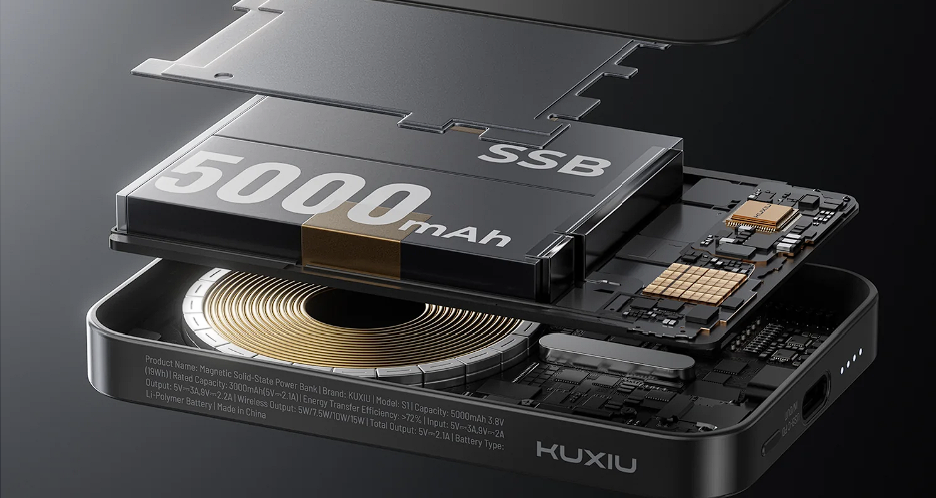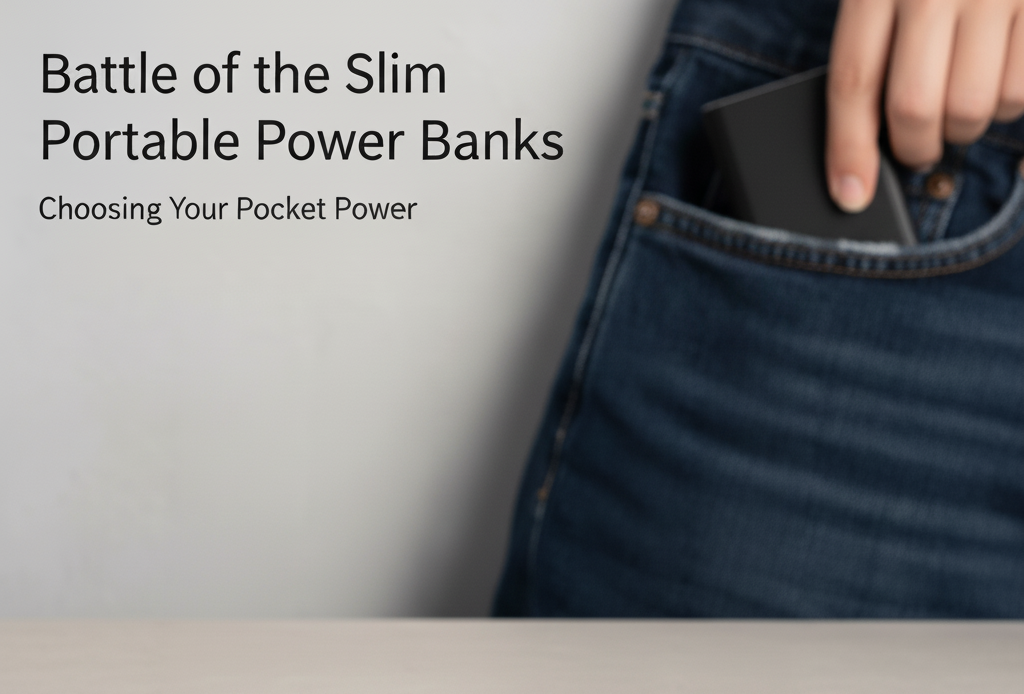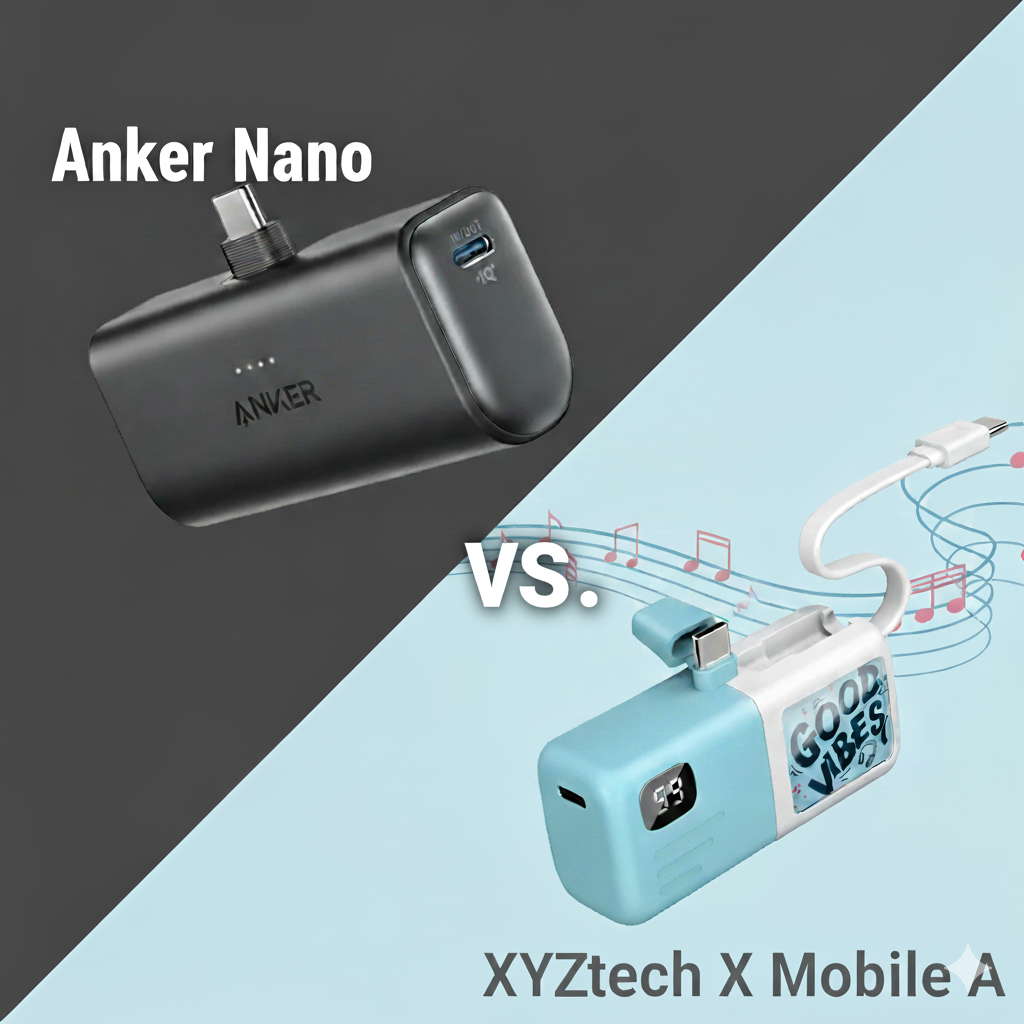Solid State Power Bank Technology: Will It Fix Lithium's Flaws?

image via Kuxiu
If you’ve ever owned a power bank (and let’s be honest, who hasn’t?), you’ve probably experienced at least one of these frustrations:
-
- It charges slower than expected (despite the "fast charging" label).
- It swells up like a balloon after a year of use (RIP, overpriced portable charger).
- It drains too fast when you need it the most (because Murphy’s Law loves tech).
For years, lithium-ion (Li-ion) and lithium-polymer (LiPo) batteries have dominated the portable power market. They’re lightweight, relatively energy-dense, and cheap to produce. But let’s be real - they come with some serious baggage and are not exactly perfect. They can overheat, wear out too soon, or just straight-up give up when you need them the most. But don’t toss your charging cable in despair just yet. There’s a new contender stepping into the ring: the solid-state power bank.
So, what’s all the buzz about a solid-state battery power bank? More importantly, can solid-state tech actually fix the annoying flaws that plague our trusty (but sometimes moody) lithium power banks?
Let’s find out!
New Solid-State Battery Technology: Let’s Talk About It!
At its core, a solid-state battery replaces the traditional liquid or gel electrolyte (the medium that helps move lithium ions between the positive and negative electrodes) with a solid material. This solid electrolyte can be made from ceramics, glass, sulfides, or even certain polymers.
That simple switch might sound small, but it changes the game in several big ways. By eliminating the flammable liquid component, the new solid-state battery technology becomes inherently safer, less prone to leakage, and better suited for miniaturization and high-density designs. It also opens the door to using lithium metal anodes, which offer significantly more energy capacity than the graphite anodes used in conventional lithium-ion batteries.
In theory, solid-state batteries promise:
- Higher energy density (translation: longer battery life)
- Faster charging times
- Greater safety and thermal stability
- Longer lifespan and durability
- More stable performance in extreme temperatures
Sounds dreamy, right? Let’s dig into why this matters for power bank users.
The Lithium Woes: What Needs Fixing?
Most lithium-ion power banks today are like that friend who’s great until they’re not. Sure, they work—until they start overheating, aging fast, or taking forever to recharge.
Here are some pain points we all know too well:
- Safety Concerns: Lithium-ion batteries are notorious for getting hot under pressure. In rare (but scary) cases, they can even catch fire.
- Short Lifespan: After a few hundred cycles, your power bank might hold a charge like a sieve holds water.
- Slow Charging: Nobody wants to wait four hours for a charge that only lasts two.
- Limited Temperature Tolerance: Leave your power bank in a hot car? It might just throw a fit and refuse to work properly.
These common power bank issues aren't deal-breakers for everyone, but they certainly leave room for improvement. This is exactly where a solid-state battery power bank is stepping in with some serious potential.
How A Solid-State Power Bank Could Change the Game
Let’s imagine a world where your power bank doesn’t need to be babied, charged overnight, or replaced every year. Sounds great, right? Here's how the new solid-state battery technology might make that fantasy a reality:
1. Better Safety = Peace of Mind
- Because solid-state batteries use non-flammable solid electrolytes, they dramatically reduce the risk of overheating, thermal runaway, or fires. This means you can toss your power bank into your bag, even if it shares space with keys, cables, or that mystery granola bar from last month, without the fear of a mini explosion.
For people who travel frequently or rely on power banks in active environments like hiking, biking, or commuting, this level of safety is a game changer. No more second-guessing whether it's safe to charge your phone while it's in your coat pocket.
2. More Juice in a Smaller Package
- Solid-state batteries pack a higher energy density compared to their liquid counterparts. That means more power in a smaller, sleeker form. Imagine a power bank that's thinner than your smartphone but still capable of delivering multiple full charges. We're talking about compact powerhouses that don’t feel like carrying a brick around.
This added efficiency can also open doors for ultra-portable designs—think integrated power cases, wearable chargers, or multi-device packs that are easy to stash in a jacket or even a back pocket.
3. Faster Charging = Less Waiting Around
- No one likes tethering their devices for hours. One of the most exciting promises of the new solid-state battery technology is ultra-fast charging. Because solid electrolytes allow for quicker ion movement with less resistance, they could significantly cut down charge times for both the power bank and your devices.
Imagine recharging your entire power bank in under 30 minutes and then having it ready to revive your dead phone multiple times. For time-strapped users, this is not just a convenience—it’s a revolution.
4. Longevity That Lasts (Finally!)
- Conventional lithium-ion batteries degrade relatively quickly, with most losing capacity after 300 to 500 charge cycles. Solid-state batteries, on the other hand, are more resilient. Their solid structure makes them less prone to wear and chemical breakdown, which means they can last thousands of cycles with minimal performance drop.
This translates to years of use without the frustration of watching your once-trusty power bank struggle to provide a single full charge. Plus, fewer replacements mean less electronic waste, which makes solid-state an environmentally friendlier option, too.
5. Performance in Extreme Conditions
- Solid-state batteries are also better suited for extreme environments. Whether it’s a freezing ski trip or a scorching beach day, they handle temperature fluctuations more gracefully than traditional lithium packs. That’s a huge plus for adventurers, travelers, and anyone living in areas where seasons aren’t just suggestions.
So, not only will your future solid-state power bank be safer and faster, it might also be more reliable wherever life takes you.
Solid-State Battery Power Bank: Why Aren’t They Everywhere Yet?
Alright, before you toss your current power bank in the junk drawer, here’s the reality check. Solid-state battery technology, while promising, is still in development for mass-market applications.
The challenges? Oh, just a few:
- Manufacturing costs are still high
- Scaling production to meet demand is tricky
- Material limitations (some solid electrolytes are brittle or unstable)
That said, companies like Toyota, Samsung, and QuantumScape are throwing major R&D money at solving these problems. Some early prototypes are already out there, and a few solid-state power banks are even hitting niche markets. So, while we're not quite at "replace all your lithium power banks now" levels, the revolution is definitely in the works.
Should You Upgrade Now or Wait for the Solid Future?
If you’re the type who loves future-proofing your tech, a solid-state power bank is definitely worth watching. Over the next few years, we’ll likely see:
- Hybrid models combining both lithium-ion and solid-state elements
- Premium solid-state power banks targeted at early adopters and professionals
- Steady price drops as manufacturing improves and production scales up
Should you hold out or go shopping now?
- Here’s the deal: If your current power bank is working fine, and you’re not in desperate need of a change, waiting for solid-state options might be worth it. They promise real improvements in safety, efficiency, and longevity—but aren’t quite mainstream (yet).
- On the flip side: If you're stuck with a bulky, overheating brick that takes forever to charge your devices, there's no harm in exploring the latest high-performance lithium-based models already available. Some come with better thermal management, faster charging, and smart features that make a noticeable difference.
Solid-state is on the horizon, but for now, it’s all about weighing your current needs with a healthy dash of anticipation for what’s to come.
Final Thoughts: A Solid Future Ahead
Solid-state power bank innovation isn’t just some sci-fi fantasy. It’s a real, tangible advancement that could fix many of the frustrating flaws we've put up with for far too long. From better safety and longevity to more efficient performance, the benefits of a solid-state battery power bank are hard to ignore.
So, while you might not be tossing out your lithium buddy tomorrow, it’s safe to say the future of portable power is looking solid—pun 100% intended.
Stay charged!
Frequently Asked Questions
Q: Will solid-state batteries be more expensive?
At first, yes. Like any cutting-edge tech, solid-state power banks will likely come with a higher price tag when they hit the mainstream. However, prices are expected to drop as production scales up and competition increases. Plus, because they last longer and perform better, you might end up saving money in the long haul.
Q: Are there any solid-state power banks available on the market right now?
They're starting to pop up, but availability is still very limited. Most solid-state battery applications are still in the prototype or early launch phase, often in premium or industrial-grade products. A few startups and tech companies are teasing early models, but mainstream, affordable versions are likely a year or two away from hitting shelves.
Q: How do solid-state batteries perform in cold or hot weather?
One of the standout perks of solid-state batteries is their better temperature tolerance. Unlike lithium-ion, which tends to struggle in extreme heat or cold, solid-state batteries remain more stable and efficient. That means your power bank is less likely to glitch out or lose capacity on a ski trip or summer hike—win-win!




